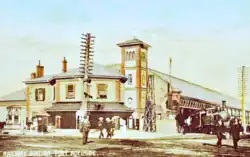Port Dock | |
|---|---|
 An artist’s impression of the new station and plaza | |
| General information | |
| Location | St Vincent Street and Lipson Street Port Adelaide |
| Line(s) | Outer Harbor Line |
| Distance | 12.0 kilometres (7.5 miles) from Adelaide railway station |
| Platforms | Open |
| Bus routes | Yes |
| Construction | |
| Parking | Yes |
| Bicycle facilities | Yes |
| History | |
| Opened | 1856 |
| Closed | 1981 |
| Rebuilt | 1963 |
Port Dock railway station – named Port Adelaide until 1916 – was located in the commercial centre of Port Adelaide, South Australia at the corner of St Vincent Street and Lipson Street. It was the original terminus of the railway between Adelaide and Port Adelaide, which opened in 1856.
After closure in 1981, the passenger station site was redeveloped as the Port Adelaide Police Station and Magistrates' Court. The former goods yard, adjacent to Lipson Street, is now occupied by the National Railway Museum. Several proposals had been advanced to build a new station, including a budgeted project by the government of South Australia in 2017,[1][2] but were put on hold by the incoming Marshall government in 2019.[3][4] Having made construction of the new line an election commitment in 2022,[5] the incoming government announced funding for the railway line and a new station in December 2022.[6] The Port Dock station is anticipated to reopen in 2024.[7]
History
The station was opened with the line from Adelaide in April 1856 and for the first sixty years until 1916, it was the only railway station in town and known simply as Port Adelaide. The original station was quite an impressive structure, with a large curved roof over the platforms. Facing St Vincent Street was a two-storey stone building, which also included a tower. The two side platforms were about 120–150 metres in length each, and the platform architecture was the same as the platforms at the Bowden and Alberton stations.
In February 1868 a direct line was built from Dry Creek to Port Adelaide to allow goods and minerals from the state's mid-north and the Murray River to reach the Port directly, without needing to travel via Adelaide. In 1878 a railway was opened from Port Adelaide to Semaphore. This followed a different route to today's line as far as Glanville. The Semaphore line emerged from the western side of Port Adelaide station, travelled down the middle of St Vincent Street and crossed the Port River via the Jervois Bridge before curving to join the current alignment of the Outer Harbor line into Glanville station. Steam trains travelled through Port Adelaide's commercial centre at walking speed, with the locomotive crew ringing a bell. Even at that time this arrangement was unsatisfactory for both local citizens and the railway operators.

By the end of the 19th century the goods yard had become very busy with imports and exports and there was a large engine shed and turntable to service the various steam locomotives working in the area. A number of railway lines extended from the station yard via city streets to the wharves and various private sidings. Occasional passenger boat trains also travelled directly to the wharves, transferring passengers to and from ocean-going ships which berthed in the inner harbour at the time.
Congestion around Port Adelaide yard resulted in the opening of the Rosewater Loop line in 1915 and construction of the Commercial Road viaduct, which opened in 1916. The viaduct line continued over a new bridge across the Port River and joined the existing line to Semaphore and Outer Harbor at Glanville. A high-level station was opened on the viaduct, Commercial Road. The original Port Adelaide station was renamed Port Dock to differentiate the two. After 1916, the frequent trains to and from Adelaide mostly continued to Semaphore or Outer Harbor via the new line and Commercial Road became the main railway station. Port Dock continued to be served by irregular trains from Adelaide and by peak hour workings to Dry Creek via the Rosewater Loop.
Decline
By the second half of the 20th century, the various lines leading through the streets to the wharves were cut back. Wharf access was firstly restricted to the Canal branch, then disconnected completely. Boat train traffic transferred to Outer Harbor and in due course was also eliminated.
Port Dock Station then became something of a backwater. The original buildings and remains of the arch roof were removed in 1963 and replaced with new buildings in the utilitarian style of that era. The station platforms were rebuilt to a length of about 70–80 metres to accommodate a maximum of three railcars, although it was very rare for a 3-car set to terminate at Port Dock. The station was finally closed in September 1981. The station platforms were removed in 1987 while the redundant sidings and goods sheds were redeveloped as a Bicentennial Project to house the former Mile End Railway Museum. The National Railway Museum opened on its site in Lipson Street in December 1988.
New station project
In 2017, $16.4 million was allocated in the state budget for a new station to be built next to Baker Street, near the original site. It was to be at the end of a new 1.0 km (1100 yard) spur line off the existing Outer Harbor rail line,[1][2] using the existing corridor beside the National Railway Museum that connects to the Outer Harbor railway line.[8][9] However, in June 2019 when some museum track had already been dismantled, the development was "put on hold" while a North West Planning Study was conducted; a forecast cost increase to $40 million was cited.[4][10][note 1] On-ground preparatory work was reversed in January 2020, with sleepers bought for the project being reallocated to other lines.[11]
In 2022, the state government committed $51 million for the construction of the new Port Dock Railway Line with a new station and bus interchange at Baker Street,[6] adjacent to the National Railway Museum. Site preparation works began for the new railway line in June 2023, with completion of the project expected by Late 2024.[7]
Notes
- ↑ For a double mainline connection and signalling, a 300-metre loop, about 700 metres of new line, a level crossing and basic station.
References
- 1 2 "Port Adelaide to get new train station served by 1km rail spur". ABC News. 24 June 2017. Retrieved 25 June 2017.
- 1 2 Kemp, Miles (24 June 2017). "State Budget 2017: Trains return to the heart of Port Adelaide after a 36-year absence". The Advertiser. Adelaide. Retrieved 15 July 2017.
- ↑ Eccles, David (20 June 2019). Marshall Govt derails Port Dock railway line InDaily. Retrieved 28 March 2023.
- 1 2 Sutton, Malcolm (21 June 2019).Adelaide's public transport going back to the future under Stephan Knoll ABC News, Retrieved 21 June 2019.
- ↑ Kelsall, Thomas (17 March 2022), Labor's $52m pledge to get Port Adelaide rail extension back on track InDaily. Retrieved 28 March 2023.
- 1 2 Port Dock Railway Line Project Update Press release, December 2022. Department for Infrastructure and Transport. Retrieved 28 March 2023.
- 1 2 "Port Dock Railway Line Project". PTP Alliance. Retrieved 15 June 2023.
- ↑ Pisani, Ashleigh (30 June 2017). "National Railway Museum warns issues to resolve before Port Dock Railway spur can return". Portside Messenger. Adelaide. Retrieved 15 July 2017.
- ↑ Pisani, Ashleigh (18 July 2018). "Barossa Wine Train booted from the Port". Portside Messenger. Adelaide. Retrieved 1 August 2018.
- ↑ Sampson, Bob (July 2019). "DPTI News". Catch Point Magazine. Port Adelaide: National Railway Museum. p. 6.
- ↑ Sutton, Malcolm (6 May 2021). Port Adelaide community rustled up to bring 'cancelled' railway spur back to life ABC News. Retrieved 28 March 2023.
Further reading
- Rails Through Swamp and Sand – A History of the Port Adelaide Railway. M. Thompson pub. Port Dock Station Railway Museum (1988) ISBN 0-9595073-6-1